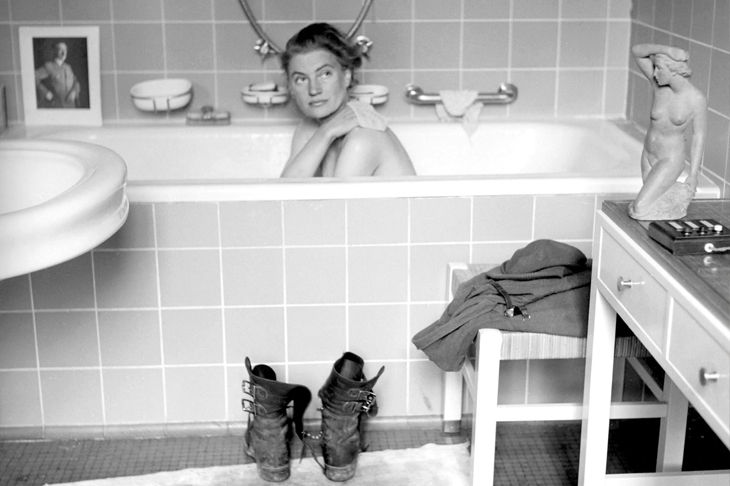Tick, tock. Tick, tock. Stay too long in the Lee Miller exhibition at the Hepworth Wakefield and the metronome might drive you mad. Considerate curators will only set it swinging in stints to spare the gallery guards. Man Ray, who made the metronome ‘Object of Destruction’ (1923), meant it to infuriate. His assembled sculpture came with instructions. ‘Cut the eye from a photograph of one who has been loved but is seen no more. Attach the eye to the pendulum of a metronome and regulate the weight to suit the tempo desired. Keep going to the limit of endurance. With a hammer well-aimed, try to destroy the whole at a single blow.’ Tick, tock. Tick, tock. Smash.
The eye on Man Ray’s metronome was Lee Miller’s, beautiful, blue, bewitching. It was an eye that had gazed unblinkingly from the cover of Vogue. Miller, a small-town girl from unpronounceable Poughkeepsie, born in 1907, was photographed from childhood by a too fond father, raped aged seven by an unnamed relative, treated for venereal disease as a teenager. Some might have crumbled. Miller was a tough Poughkeepsie cookie. She took herself to Manhattan, where, crossing the road, she was saved from the path of a car — a bit of luck at last — by Condé Nast, publisher of Vogue. She modelled for his magazine, but it bored her. She declared that she would ‘rather take a picture than be one’.
Aged 22, Miller moved to Paris, took up with Man Ray, took up a camera. Her Paris is a strange place. She photographed rats lined up like a can-can chorus. She poseda severed breast from a medical-school mastectomy on a dinner plate as if it were a pie spilling mincemeat. Shudder. She was weird, brave and brilliant. In London, during the war, she reinvented herself as a photojournalist. She covered the aftermath of the D-Day landings and the liberation of Paris. She was among the first to enter Dachau.
‘Surrealism was the backbone of her work,’ says curator Lauren Barnes. And what a backbone. Black-and-white photographs, stark as X-rays, show Miller’s naked spine bending, curled, foetal and abstracted.
It is interesting to see this exhibition with Frida Kahlo: Making Her Self Up at the V&A. They share a surreal streak. Both women survived physical traumas as girls. Miller narrowly escaped her car crash; Kahlo was hit by her trolley-bus. The pain and damage were lasting. Their bodies were dissected into parts. Kahlo’s back, her brow, her moustache; Miller’s lips and eyes. For the Surrealist Objects and Poems exhibition held in London in 1937, Miller submitted an arm wearing a bracelet of false teeth, called ‘Le Baiser’ — ‘The Kiss’. She wrote to Roland Penrose, the exhibition’s organiser and later her husband, to say what she wanted: ‘A beautiful wax hand, like [one] in a manicurist’s window standing up from the wrist, vertically and on it, I’d likea bracelet made of false teeth mounted in particularly false pink-coloured gums.’ Penrose wrote back: ‘I shall love to choose a hand as nearly like yours as possible and decorate it with teeth as nearly like mine as possible.’ That’s surrealist flirting for you.
This is a smart, warm, wise exhibition. Miller’s life is sketched out as background to the work; it is not the whole sensational story. The first rooms establish her in her milieu, first in Paris, later in London and at Farley Farm, the home she made with Roland and their son Antony in Sussex. Do visit. It’s as they left it, Picasso’s single tile above the hob. At the Hepworth, there are one or two also-rans — Tristram Hillier and John Melville doing a sub-Salvador Dali shtick — but many treats: Graham Sutherland’s lettering for a surrealism exhibition catalogue (1937) with tree roots spelling the names Picasso, Ernst, Moore, etc.; Joan Miro’s ‘Adam & Eve’ (1925); Paul Nash’s ‘Event on the Downs’ (1934). Here are Miller’s photographs of Henry Moore hugging his ‘Mother and Child’ sculpture in the Farley Farm garden. In another photograph, Antony Penrose, Mary Moore and Mary Moore’s teddy bear play on the grass. Miller could do sweetness, as well asthe macabre.
Most surreal of all, more disturbing than Dali’s lobster telephone, is Miller’s famous self-portrait taken in Hitler’s bath. Here, truly, is the banality of evil. Pretty Miller in Hitler’s tub, a portrait of the Führer propped up next to the soap dish, the nailbrush and flannel, her muddy boots on the bath mat. You shrink from her photographs of Buchenwald, as you do from the severed Paris breast. Her photographs repel and magnetise. Vogue didn’t know what to do with the bath photograph, says co-curator Hilary Floe. ‘They buried it, printed tiny in the back matter.’
Cecil Beaton, Miller’s Vogue contemporary, said London had been ‘bombed into Surrealism’ by the Blitz. Miller captures this with eerie efficiency in her portraits of models in gas masks. This season’s must-have. Everyone’s wearing one, darling. Miller thought up the title ‘Grim Glory: Pictures of Britain Under Fire’ for one of her Vogue spreads. That goes for all of Miller’s strange body of work: grim and glorious.







Comments